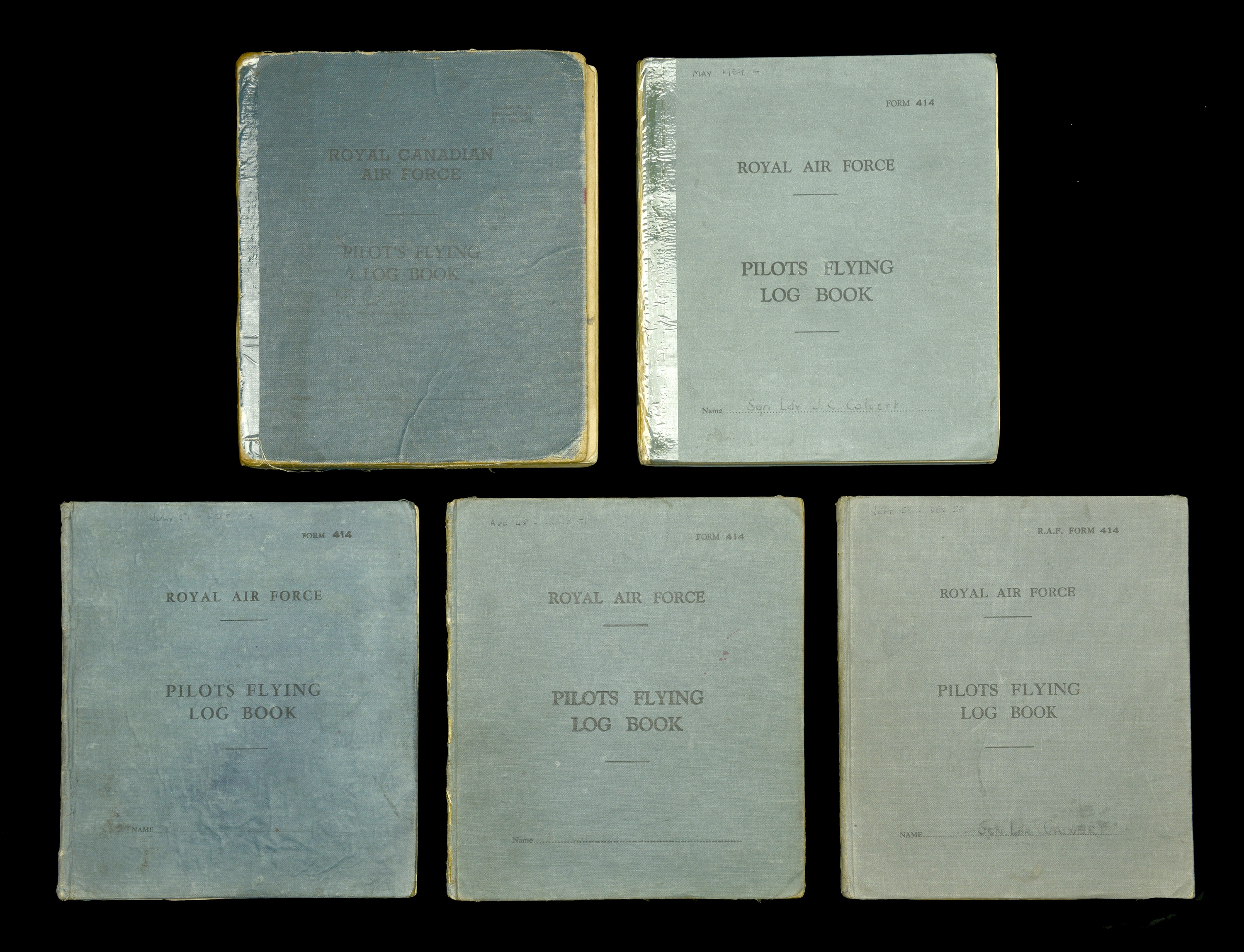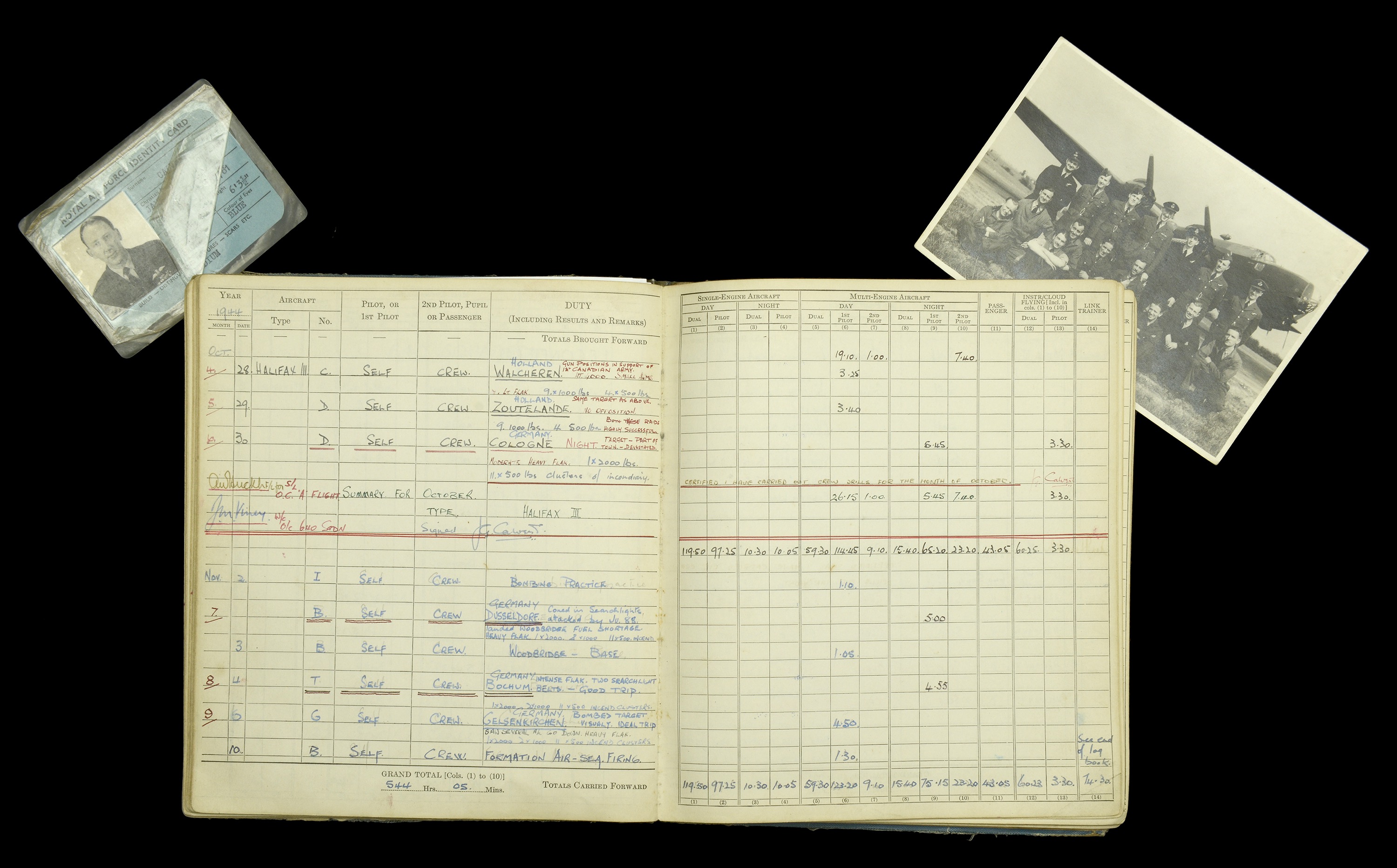Royal Air Force Pilot’s Flying Log Books pertaining to Wing Commander J. G. Calvert, D.F.C., 640 Squadron, Royal Air Force, a Halifax pilot who completed a tour of 33 night time and daylight sorties against some of the most heavily defended enemy targets in the Ruhr valley; post-War, he subsequently flew another 163 sorties during the Berlin Airlift 1948-49 Five Log Books, the first a Royal Canadian Air Force Pilot’s Log Book covering the period 5 September 1942 to 7 June 1948, well-annotated with details of all operational sorties undertaken; the second to fifth the recipient’s post-War Royal Air Force Pilot’s Flying Log Book covering the periods August 1948 to June 1951; July 1951 to September 1953; September 1953 to December 1958; and May 1959 to March 1965, some pages slightly loose, and the spines damaged and reinforced with sellotape throughout, otherwise good condition (5) £400-£500 --- D.F.C. London Gazette 22 May 1945. The original Recommendation states: ‘On the night of the 2nd February 1945, this Captain was detailed to attack Dusseldorf and during the bombing run his aircraft was attacked by a J.U. 88. In spite of this Flying Officer Calvert was determined to hold the same course, in order to allow the Bomb Aimer to release his bombs on the objective. The decision on the part of the pilot to disregard the danger of fighter attack called for the highest degree of fortitude and determination to successfully conclude his mission. Once again, on the night of the 17th December 1944, the target being Duisburg, this Captain's aircraft was attacked by an enemy night fighter a few miles from the target, and a running fight followed, with the result that the enemy aircraft was claimed as destroyed. Although considerable height was lost during the combat, Flying Officer Calvert settled down to a bombing run and it was not until his bombs had found their objective that the pilot set course for base. The above are but two of the instances where this officer has shown the utmost disregard for his personal safety, placing the satisfactory completion of his mission before all other considerations. He has also led his Squadron on daylight attacks to the most heavily defended Ruhr cities, displaying leadership and courage of the highest order. I therefore have no hesitation in recommending this officer for the non-Immediate award of the Distinguished Flying Cross. Remarks by Station Commander: During his operational tour this Officer has carried out a number of varied and difficult sorties which have included a series of attacks, both by day and by night, on Ruhr targets, and others of equal importance throughout Germany which were vital to the enemy's war effort and where the opposition was powerful. During this time Flying Officer Calvert has displayed consistent flying skill and efficiency of a high order, and his courage and dash have always served as a valuable example to other crews. His fine offensive spirit and operational record fully merit the award of the Distinguished Flying Cross.’ James Gordon Calvert was born in August 1923, and commenced his training at No. 32 E.F.T.S. in Alberta, Canada in September 1942. Returning to the U.K. in October 1943, and having attended further courses, he was posted to No. 640 Squadron, a Halifax unit operating out of Leconfield, Yorkshire, in early October 1944, in which month he completed six sorties, including two strikes against the Krupps works at Essen, a raid on Cologne, and two trips to Holland against enemy gun positions in support of the 1st Canadian Army. Calvert flew another half dozen operations in November, all against German targets, the first to Dusseldorf on the night of the 7th-8th, when his Halifax was coned by searchlights amidst heavy flak - and attacked by a Ju. 88. Bochum having been attacked on the 8th-9th (’Intense flak. Two searchlights’), and Gelsenkirchen on the 9th-10th (’Heavy flak. Saw several a/c go down’), he flew on strikes against Julich, Munster and Sterkrade. In December, after a sortie to Solst, Calvert and his crew were ordered to attack Osnabruck on the night of the 6th-7th, his Flying Log Book once more noting heavy flak - and a feathered port outer engine. Duisburg ten days later proved even more challenging, his Halifax being attacked on four occasions by an enemy night fighter ... ‘Destroyed same. Lost 6,000 feet.’ And a sharp reminder of ever present threat of enemy night fighters came again on the night of 5-6 January 1945, during a raid on Hannover, Calvert noting ‘Bags of N. Fighters. 32 lost on this night’s sortie.’ Luckily his trips to Dortmund, Ludwigshaven and Stuttgart in the same month appear to have been of a smoother nature. February 1945 witnessed Calvert flying several more sorties, including strikes against Mainz, Goch and Wanne Eickel, but it was an attack against Worms on the night of 21st-22nd that proved the highlight, his Flying Log Book noting, ‘Intense searchlight activity. Moderate flak. Saw seven a/c shot down by fighters.’ While in March, the final month of his operational tour, he appears to have enjoyed smoother trips against Hemmingstedt, Homburg and Witten. Tour expired, he was awarded the D.F.C. and posted to Transport Command. Post-war, Calvert joined No. 47 Squadron, a Hastings unit based at Dishforth, in which capacity he flew a remarkable tally of 163 sorties during the Berlin Airlift, between November 1948 and August 1949. He then instructed on Meteors with Flying Training Command, in addition to similar duties on secondment to the Luftwaffe in the early 1960s. Having then been advanced to Wing Commander, and attended the N.A.T.O. Defence College in Rome, he was posted to N.A.T.O’s Southern Europe H.Q. in Naples, from which latter establishment he returned to the UK in 1975; shortly after which, as a result of ill-health, he was placed on the Retired List. Sold with details of the recipient’s operational sorties, taken from the Squadron Operations Book; copied birth and death certificates; various newspaper cuttings; and other ephemera, including a NATO Defense College bronze medallion embossed ‘Wing Commander J. G. Calvert’.






